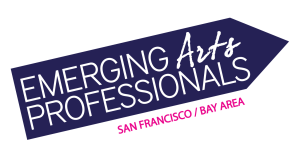News 10.26.09
In this Issue
~ Career Trajectories : Not All Straight Arrows – Listen to Maia Rosal, Marc Vogl and Evelyn Orantes
~ The Emerging Leader Salon on ARTSblog hosted by 20under40 and the Emerging Leader Networks of Americans for the Arts
~ GrantMakers in the Arts 2009 – Brooklyn: New Leaders & New Models
~ Great Links from You!
~~~~~~~~~~~~~~~~~~~~~~~~~~~~~~~~~~~~~~~~~~~
Hi!
Career Trajectories : Not All Straight Arrows – Listen to Maia Rosal, Marc Vogl and Evelyn Orantes
How is your fall going so far? Well I hope. Thanks so much to everyone who made it out to Creative Conversation 2009: Career Trajectories : Not All Straight Arrows at the Oakland Asian Cultural Center. If you missed it, Check out our FaceBook page for a link to recordings and photos.
The Emerging Leader Networks of Americans for the Arts are hosting over forty Creative Conversations all over the country during October, National Arts & Humanities month. It’s an interesting glimpse into what’s on the mind of our peers nationwide. Building Leadership Capacity in TX, Leveraging Networks in Long Beach, Arts & Social Entrepreneurship in NY.
The Emerging Leader Salon on ARTSblog hosted by 20under40 and the Emerging Leader Networks of Americans for the Arts
Last week, the Emerging Leaders Network of Americans for the Arts and the 20UNDER40 anthology hosted an Emerging Leaders Salon on ARTSblog. Diverse arts professionals discussed the impending generational shift in arts leadership and the value of emerging leaders to the field. Read the posts and continue the conversation through your ideas, comments, and personal stories.
One of my favorites – Never Mind “What Do We Do Next?” What Do We Do FIRST? And Who’s Going to Fund It? – By Eric Clapp, editor and project director of 20UNDER40 and a doctoral student at the Harvard University Graduate School of Education.
GrantMakers in the Arts 2009 – Brooklyn: New Leaders & New Models
Speaking of who’s gonna fund it, I was lucky enough to attend the Grantmakers in the Arts (GIA) conference in Brooklyn last week. This years theme – Recession : Navigating the Art of Change. For the first time GIA invited a blogger to cover the conference in its entirety, emerging leader Ian Moss. Yeah! An account of the proceedings, with a great finale – Brunch with Rocco – the closing speech by recently appointed chairman of the National Endowments for the Arts, Rocco Landesman is available here: His message ART WORKS.
This was my first time at a GIA conference and I was honored to participate in a panel titled, Changing the Game: New Models, New Leaders, New Ideas for the Arts with Heather Cohn, managing director, Flux Theatre Ensemble; Nicole Derse, national training director, Organizing for America and Adam Huttler, executive director, Fractured Atlas.
Big ups to all the California and Pittsburgh, PA (my hometown) people who took the time to say hello. It was lovely to see you in Brooklyn.
7 Great Links from You!
And Thanks for sharing!
1.) Can foundations co-op social movements? In Creating a Monster: Capitalism in the Community Arts Classroom, a young arts administrator asks “How can we overcome the dominant power structure of corporate-controlled foundations?”
2.) A posting on the topic of “How’s this whole nonprofit thing working out for you?” from the Harvard Business Review.
3.) Have you heard? The Freelancers Union is modernizing the labor movement.
4.) Insightful stories from six senior executives who have spent their entire careers in the nonprofit sector about how they moved into leadership roles. Great tips!
5.) Tim Brown, the chief executive of the design firm IDEO, says leaders may not have all the answers, but need to ask the right kinds of questions.
6.) Great TED talk from Elizabeth Gilbert, author of Eat, Pray, Love on nurturing creativity, brushing up against genius and staying sane.
7.) Wow! A comprehensive 5-point plan to strengthen New York’s art sector. There are some great ideas here.
Thanks for reading!
Do you have great links to share? Post them on the FaceBook page. Let’s build up this pool of knowledge.

